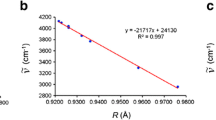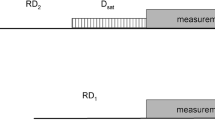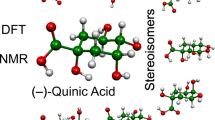Abstract
An ‘isotopomer-selected NOE’ (ISNOE) method for the unequivocal identification of mutually hydrogen-bond-linked hydroxyl groups is described. It relies on the fact that the OH group's signal patterns obtained for a partially deuterated sample originate from both isotopomers of the ‘partner’ hydroxyl, whereas a NOE for this group can originate from cross-relaxation with the protio isotopomer of this hydroxyl only. Hence, the isotopically shifted component of this group's signal does not appear in a ROE difference spectrum obtained with selective excitation of the ‘partner’ hydroxyl. This method is also applicable in those cases when only one of two mutually hydrogen-bonded groups exhibits resolvable isotope shifts. Furthermore, it is shown that isotope shifts may occur even for pairs of OH groups that are not mutually hydrogen-bonded, if these participate in hydrogen bonds with other hydroxyls and thereby affect conformational equilibria. The ISNOE experiment enables one to distinguish between these two sources of isotope shifts. Since the O⋅⋅⋅O distance for hydrogen-bonded hydroxyls in sugars is known to lie between 2.7 and 3.0 Å , the hydrogen bonds established by ISNOE can be used in conformational analysis as reliable, motionally non-averaged distance constraints for the conformations containing these bonds.
Similar content being viewed by others
References
Angyal, S.J. and Christofides, J.C. (1996) J. Chem. Soc., Perkin Trans. 2, 1485–1491; and references therein.
Bock, K. and Lemieux, R.U. (1982) Carbohydr. Res., 100, 63–74.
Buckingham, A.D. and Fan-Chen, L. (1981) Int. Rev. Phys. Chem., 1, 253–269.
Christofides, J.C. and Davies, D.B. (1982) J. Chem. Soc., Chem. Commun., 560–562.
Craig, B.N., Janssen, M.U., Wickersham, B.M., Rabb, D.M., Chang, P.S. and O'Leary, D.J. (1996) J. Org. Chem., 61, 9610–9613.
Cumming, D.A. and Carver, J.P. (1987) Biochemistry, 26, 6664–6676.
Dabrowski, J., Kozar, T., Grosskurth, H. and Nifant'ev, N.E. (1995) J. Am. Chem. Soc., 117, 5534–5539.
Hansen, P.E. (1988) Prog. Nucl. Magn. Reson., 3, 207–255.
Janoschek, R. (1996) Mol. Phys., 89, 1301–1311.
Jardetzky, O. (1980) Biochim. Biophys. Acta, 621, 227–232.
Jeffrey, G.A. and Saenger, W. (1991) Hydrogen Bonding in Biological Structures, Springer, Berlin.
Khatuntseva, E.A., Sherman, A.A., Shashkov, A.S., Dabrowski, J. and Nifant'ev, N.E. (1997) Bioorganicheskaya Khimiya, 23, 228–233; Russian J. Bioorg. Chem., 23, 205–210.
Kozar, T., Nifant'ev, N.E., Grosskurth, H., Dabrowski, U. and Dabrowski, J. (1995) 1st Electronic Glycoconjugate Conference (EGC-1); Kozar, T., Nifant ev, N.E., Grosskurth, H., Dabrowski, U. and Dabrowski, J. (1998) Biopolymers, in press.
Lemieux, R.U. and Bock, K. (1979) Jpn. J. Antibiot. Suppl., 32, 163–177.
Nifant'ev, N.E., Amochaevan V.Y., Shashkov, A.S. and Kochetkov, N.K. (1993) Carbohydr. Res., 250, 211–230.
Nifant'ev, N.E., Mamyan, S.S., Shashkov, A.S. and Kochetkov, N.K. (1988) Bioorg. Khim., 14, 187–197.
Poppe, L., Dabrowski, J., Lieth, C.-W.v.d., Koike, K. and Ogawa, T. (1990a) Eur. J. Biochem., 189, 313–325.
Poppe, L., Lieth, C.-W.v.d. and Dabrowski, J. (1990b) J. Am. Chem. Soc., 112, 7762–7771.
Reuben, J. (1984) J. Am. Chem. Soc., 106, 6180–6186.
Scheiner, S. and Cuma, M. (1996) J. Am. Chem. Soc., 118, 1511–1521.
Siehl, H.-U. (1987) Adv. Phys. Org. Chem., 23, 63–163.
Author information
Authors and Affiliations
Rights and permissions
About this article
Cite this article
Dabrowski, J., Grosskurth, H., Baust, C. et al. Secondary H/D isotope effect on hydrogen-bonded hydroxyl groups as a tool for recognizing distance constraints in conformational analysis of oligosaccharides. J Biomol NMR 12, 161–172 (1998). https://doi.org/10.1023/A:1008237308320
Issue Date:
DOI: https://doi.org/10.1023/A:1008237308320




